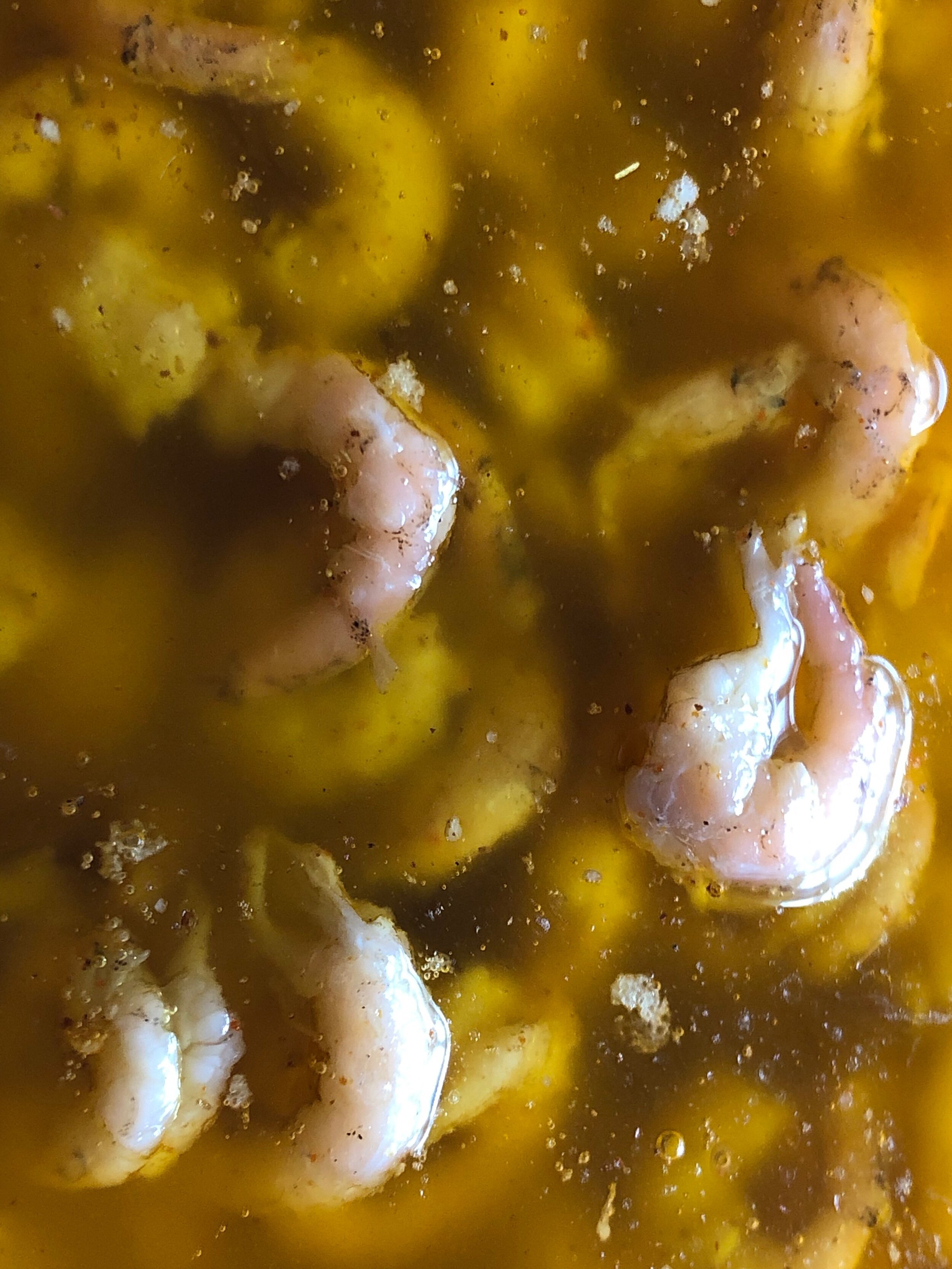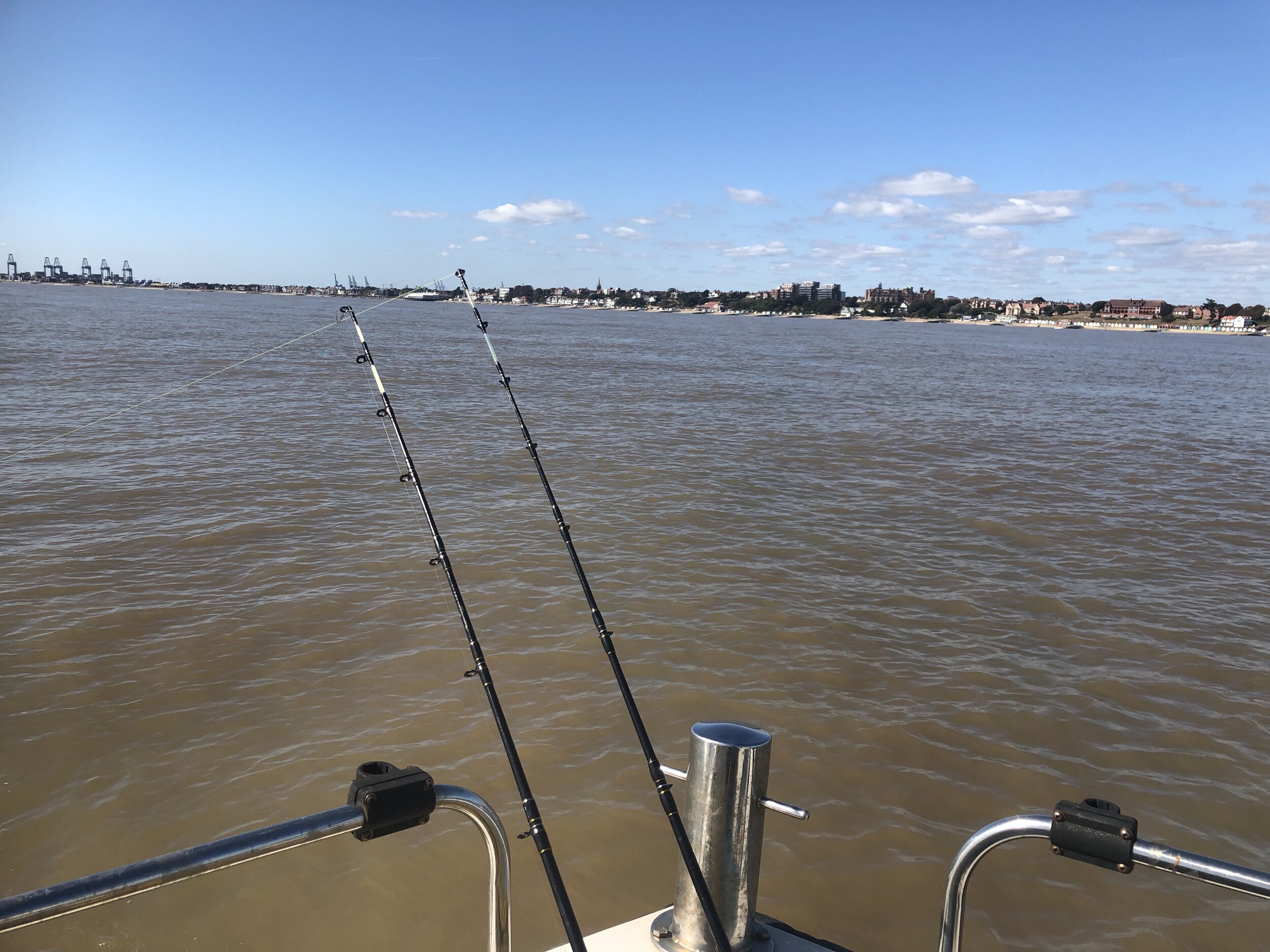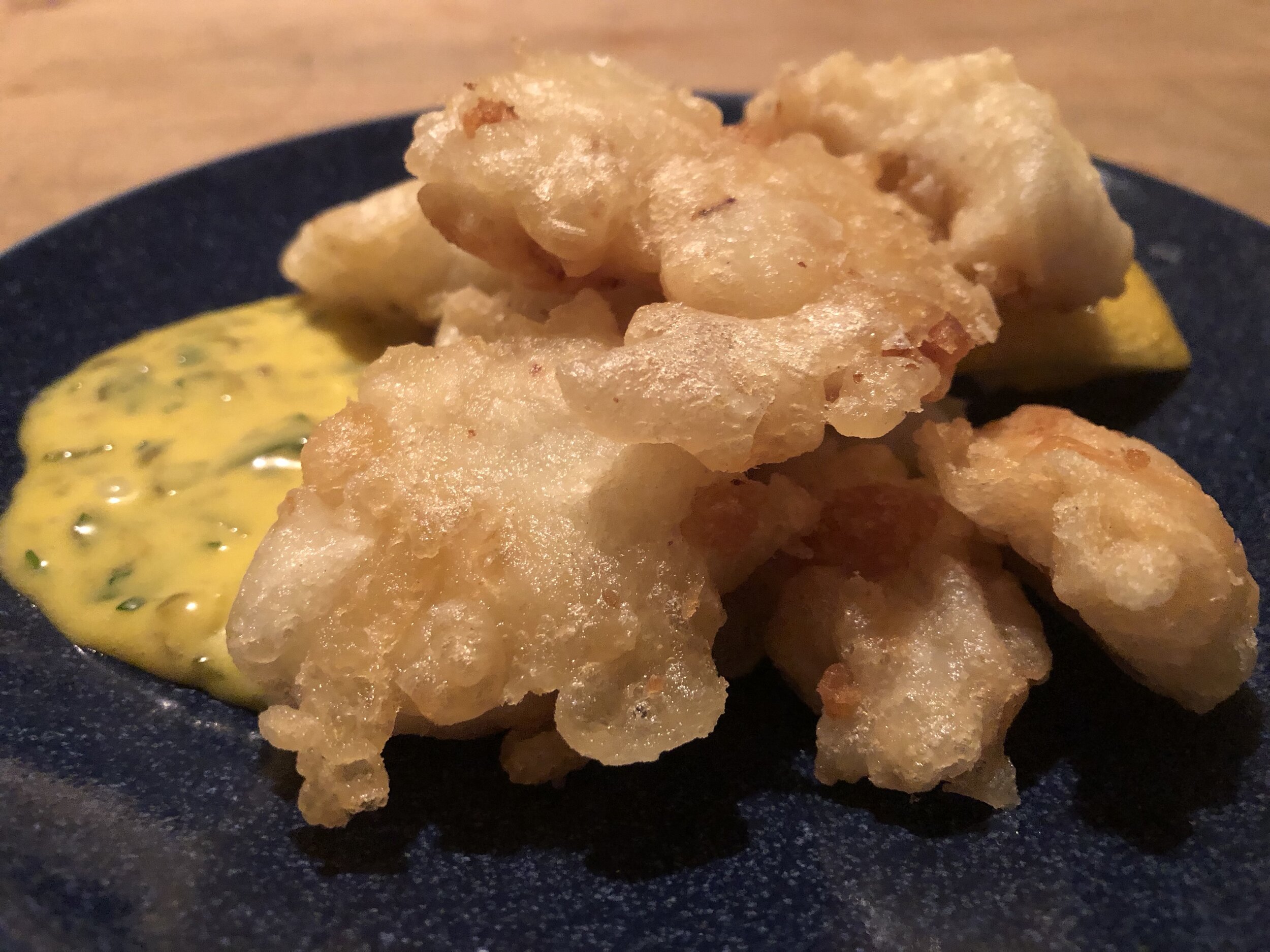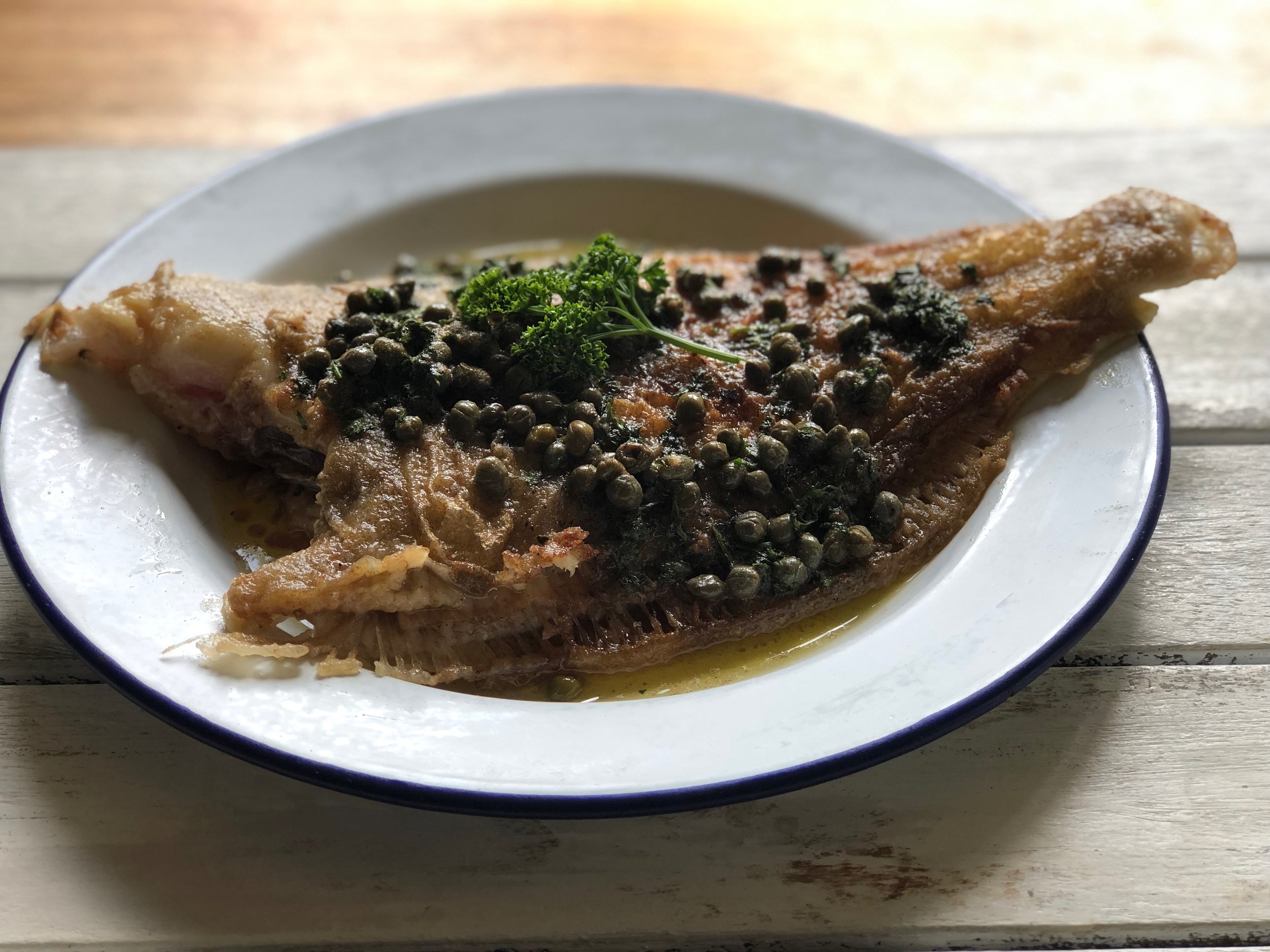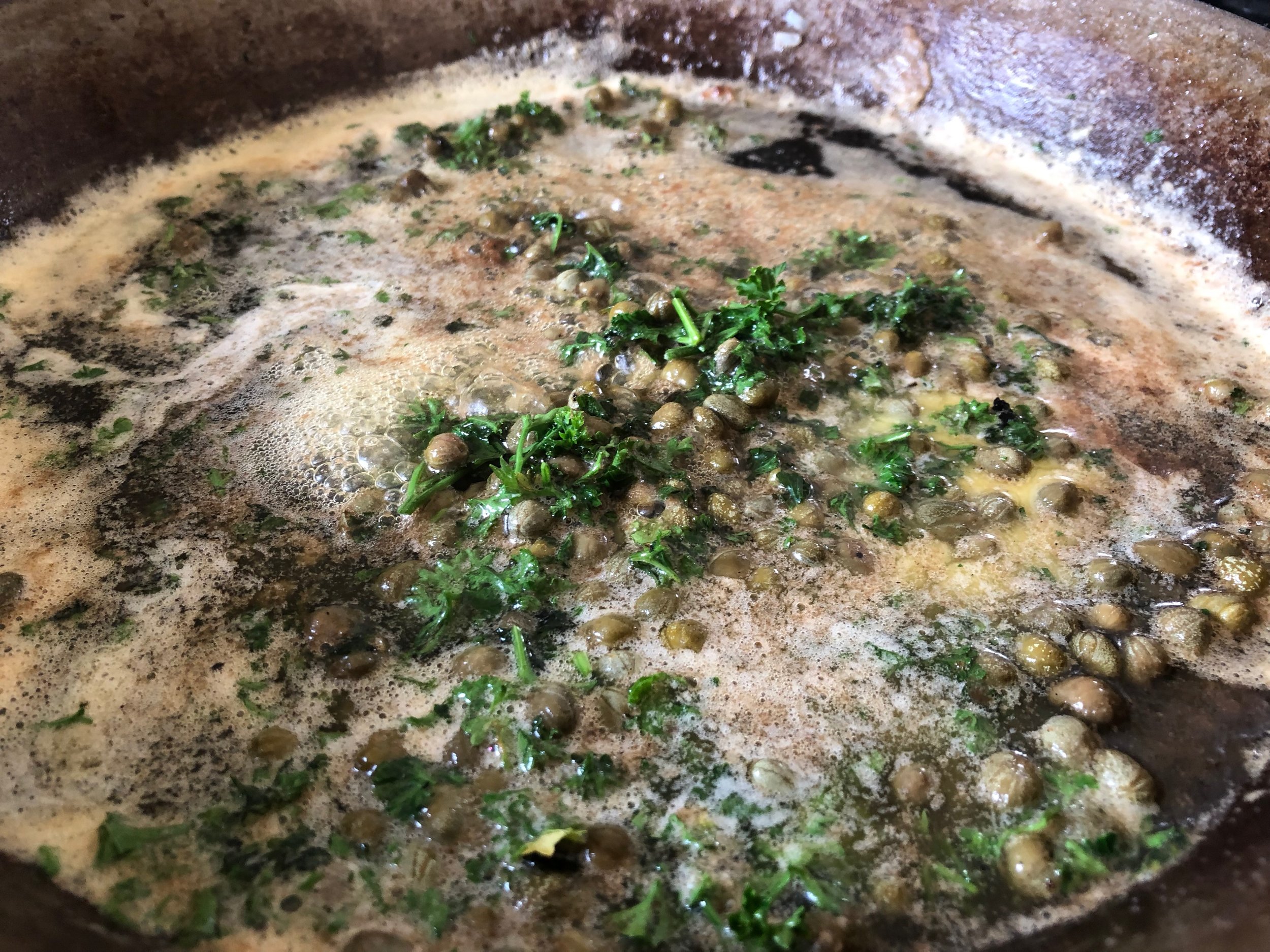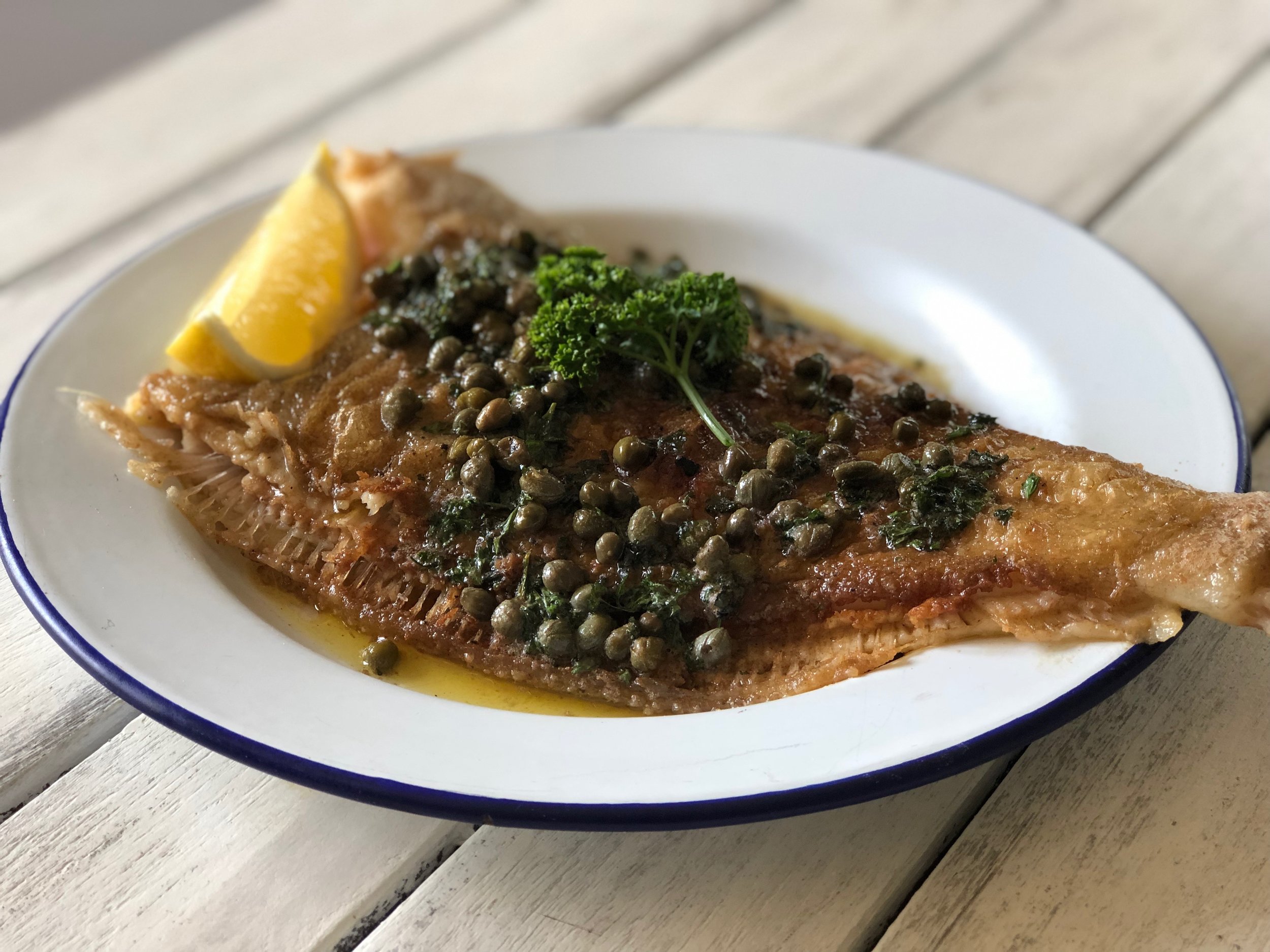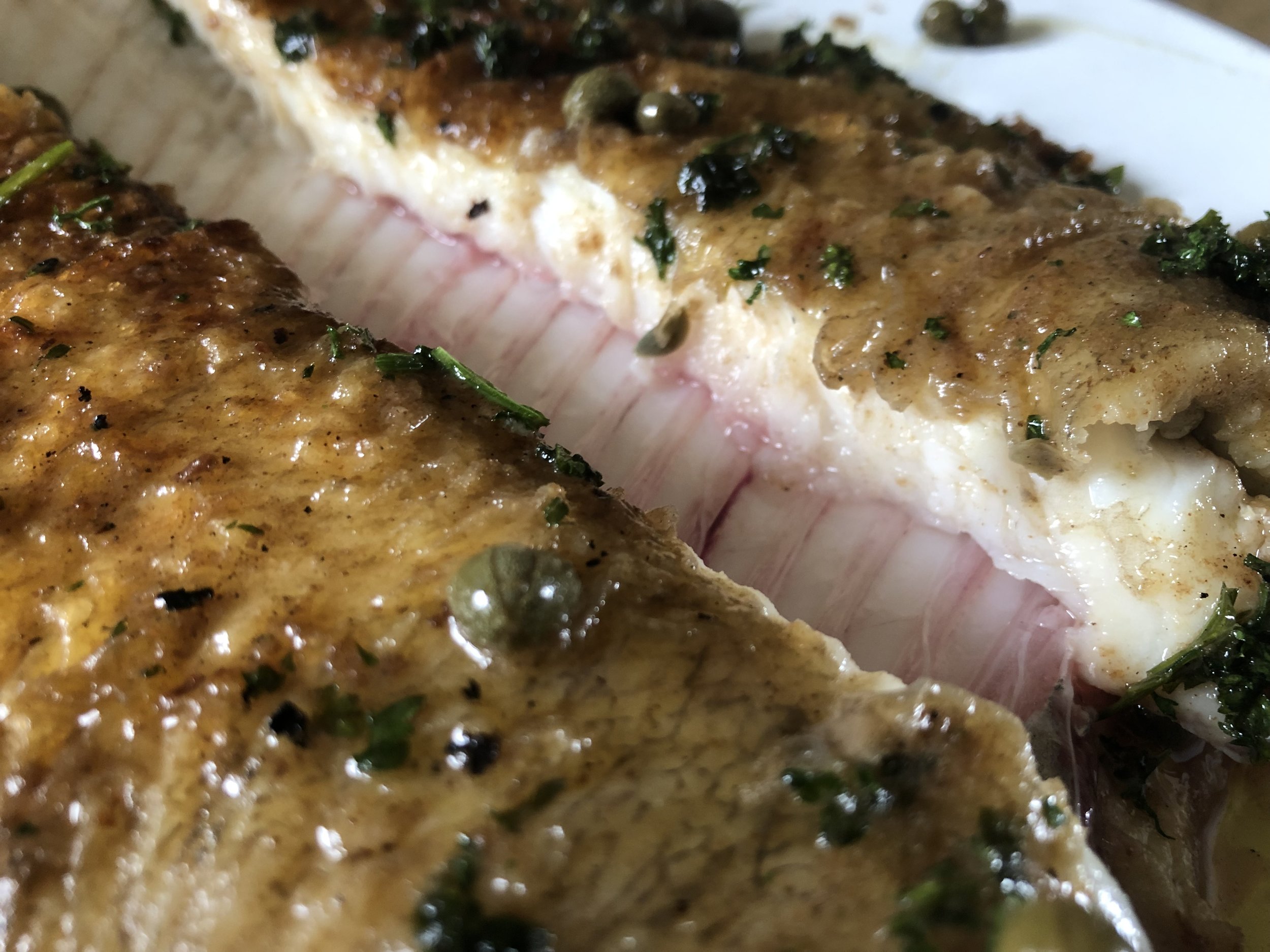Homemade Potted Shrimps
Brown shrimps are yet another one of those locally-abundant seasonal shellfish that mostly get exported away from our shores. Apart from in the North West, where traditional shrimping and potting are still carried out in the likes of Southport and Morecambe and the product is laboriously but very efficiently hand peeled, the bulk of our national catch (about 5000 tonnes) go to Holland for mechanical peeling, using high pressure water and compressed air. This in itself is a very effective method but I think always loses the flavour. When the shrimps return to us vac-packed and pasteurised, they seem to have mysteriously quadrupled in price too, making them off the menu for most chefs.
I however, have the luxury of being able to catch my own at low tide with my trusty push net, or buying them straight off the boat from local Lowestoft skipper, Jeffery Melton. The tastiest are undoubtedly the ones I forage for myself, though all are good and the commercial shrimp boats cook their catch aboard in sea water in a gas-fired boiler.
Cooking them on the shore, on a portable stove having just netted them from their sandy burrows is immensely gratifying. The just-cooked sweet and saline, ozonous aroma is unforgettable. The shrimps, to be enjoyed at their best, should be peeled or eaten whole straight away, (don’t worry about the shells) They are literally so moreish, I have a real job not eating them all straight off like a bag of maltesers….
But a great and very traditional way of enjoying them is to incarcerate them in spiced butter - or potted and then liberally spread over some warm, sourdough toast. Quite an old fashioned tea time treat, and a little indulgent, but then so very easy to make and of course you can use North Atlantic prawns as an alternative, if you can’t find any brownies.
Homemade Potted Brown Shrimps
Serves 2
Ingredients
1 pint of cooked and peeled brown shrimps.
250g unsalted butter
A pinch of ground mace
A pinch of cayenne
A squeeze of lemon
2 small ramekins to serve in
Soughdough or wholemeal toast to serve on.
Method
Melt the butter over a low heat and strain off the solids so you’re just left with the clarified ghee. Introduce the mace and cayenne and stir over a low heat. Let the spices infuse into the butter. Add a squeeze of lemon, before taking the peeled shrimps and tamping them down into the ramekins with the back of a spoon.
Pour the spiced butter gently over the shrimps just to the top and allow to cool and set. Dust the solidifying mix with a little more cayenne and refrigerate. The potted shrimps will keep nicely at 2-4C for a few days or you can freeze.
To serve
Take the ramekins out of the fridge and leave to stand a while at room temperature to loosen the butter. Spoon the potted shrimps onto your freshly made warm toast and savour whilst thinking of the beach. Always does it for me.
Whiting Gin Tempura with Homemade Tartare Sauce.
Early autumn on the Suffolk Coast is always heralded by the arrival of an extremely ubiquitous but very undervalued white fish - the whiting (Merlangius melangus) which are present year round inshore, but traditionally arrive in greater numbers throughout September and October. They always used to be the prelude to the inshore winter cod fishery here, but for various reasons that I won’t expound here, cod have rather dropped off the chart and we have seen any commercial number now for several years.
Whiting however yes and thank goodness, as they are so, so tasty, easy to prepare and have the lightest of textures if prepped and cooked correctly. We caught and ate a lot of them when I was growing up and generally cooked them on the bone, which although incredibly flavoursome, used to frustrate me as the bones are fine and sharp and can be tiresome. However, on a successful foray aboard ‘Avocet’ recently to fish one of my childhood fishing marks out of Felixstowe Ferry, I thought I’d share a very easy and delicious way of enjoying whiting to its max, without the bones and the fuss.
Apart from providing a good bit of sport, these little fish are a delight to eat straight out of the water. Seafood doesn’t come much fresher and if you can get hold of them this fresh or from a day-boat fishmonger, then you’ll experience the same buzz that I do. If you can, get fresh whole fish and either fillet or get the fishmonger too. We used to catch so many back in the 70’s and 80’s that it was quite common for us to have a group of folk around the boat when we landed and would gladly give them away.
Whiting Gin-Tempura with homemade Tartare Sauce.
This recipe really is another ‘less-is more’ example of enjoying fresh fish at its best. A great lighter take on fish and chips or a tapas-style dish for sharing. You don’t need to skin the whiting either, as it cooks and eats so well with very few scales.
Serves 4
Ingredients
4-6 fresh day-boat whiting (cleaned and filleted)
Well-seasoned plain flour for dredging.
150g plain flour
150g cornflour
Splash of your favourite artisan gin
Sea salt and ground black pepper.
250ml sparkling mineral water
Lemon wedges to serve
For the tartare sauce
2 fresh free-range egg yolks
200 ml groundnut oil
1 tsp Dijon mustard
2 tsp chopped capers
2 tsp chopped cornichons
Handful chopped fresh parsley
Pinch sea salt
Couple of drops of Escheta (anchovy essence).
Method
Cut the fillets into small bite-sized strips and dredge with the seasoned flour and dust off the excess.
Prepare the tempura batter by combining the flours, adding a pinch of sea salt and whisking in the sparkling water to a loose consistency. Refrigerate
Heat the oil in a shallow pan to a moderate heat and test with a drop of the batter.
Meanwhile, make a mayonnaise for the tartare sauce, by whisking the egg yolks, salt and Dijon mustard together whilst adding a steady stream of the groundnut oil. Whisk until it peaks and then fold in the chopped capers, cornichons and parsley. Add a couple of drops of the Escheta and whisk again. Refrigerate.
Dip the fish pieces in the batter to cover liberally and place in the hot oil, frying for 2 mins on either side or until crispy and very light brown. Drain on kitchen roll and serve immediately with the tartare sauce and a squeeze of lemon.
Light, fresh seasonal fish at its very best using a very sustainable alternative to cod and haddock. Works well too with pollack.
Last of the Lobsters
The end of the summer for me means the drawing in of the evenings, a nip in the air and the final hauling of the lobster pots here on the East coast. Having normally started fishing around the end of March, we make the most of the season on lobsters through until September , after which the pots come ashore for maintenance and to evade the winter storms. Much of our gear here is fished close inshore and would be smashed up on the beach after too much hard weather.
So with the last of the lobsters I always like to finish as I started - a simply boiled fish that can be enjoyed and celebrated as a fitting end to a summer’s fishing. Dressed and served with a simple homemade mayo and either some hand cut chips or sautéed second crop new potatoes. It’s a flavour that has been with us over the summer and is now time to be replaced with the next locally seasonal seafood offering.
Poached Native Lobster with Lemon Mayonnaise
Serves 2
Ingredients
1 x 500-750 g live native lobster
2 free range egg yolks
1 tsp Dijon mustard
Freshly squeezed juice of half a lemon
Pinch sea salt
Table or sea salt for the poaching liquor.
Splash white wine vinegar.
Method
Boil 3 -4 litres salted water (or preferably clean seawater) in a large saucepan. Add a dash of white wine or cider vinegar and when you have a rolling boil prepare your live lobster.
Ideally you should keep the lobster at 0-2C for an hour before dispatching (I call it a pre-med), so that stress levels are kept to a minimum. The RSPCA home method is to dispatch by cutting down through the brain and central nervous system which kills the fish instantly. Splitting it lengthways is also effective,, but obviously not for poaching, only for baking or grilling/barbequeing.
Having dispatched the lobster, pop it into the saucepan and boil/poach for approximately 8-10 mins for that size of fish. I tend not to boil too fiercely and it is very easy to over cook, and toughen the flesh. After the requisite time remove the, now beautifully red, lobster and set aside to cool at room temperature, to let the meat ‘set’. When cool enough to handle it can be served or refrigerated.
Dressing
Megrim on the bone with capers and parsley
Megrim or megrim sole or sometimes ‘whiff’ are what we call left-handed flatfish (the way their eyes are set on their head) and are found all around the UK, but tend to inhabit deeper water compared to the more inshore flatfish species like dab, Dover sole and flounder.
Typically exported - the French and Spanish adore them, they’ve never really come up on the radar for UK consumers, buy of course they should do. In season and in prime condition from Scottish, or in this case Cornish, waters megs in good nick, for me anyway, go head to head with any brill or lemon sole worth its salt.
These recipes are meant to demonstrate the innate simplicity of cooking fresh, seasonal seafood and really there’s no easier solution to cooking an amazing fish such as the meg, than on the bone with minimal fuss. Fish cookery should not be a daunting prospect and although many folk see it as being overly complicated and perhaps shy away from experimenting or even ordering off a menu and I do get that. However, a little knowledge goes a very long way and hopefully I’ll demonstrate here that less is undoubtedly more.
Megs can be found throughout the year, but in Cornwall and the South West mid-summer to autumn is probably the best time to try them. You’re more likely to buy them from an independent or coastal fishmonger, but they are there and just need to be made more of. Check the firmness of the flesh, the brightness of the eyes and the redness of the gills. The fish should smell of nothing other than the sea’s natural ozone. If you must, get your fishmonger to fillet, but maximum flavour will always come from a flatfish like this cooked on the bone.
Ingredients - serves 2
One whole fresh Cornish megrim (gutted) about 1kg
200g Cornish sea salt butter
50ml Cold pressed rapeseed oil
2 tbs capers
A good handful of fresh, chopped curly parsley
Plain flour for coating
Ground black pepper
Sea salt
Lemon to serve
Parsley sprig to garnish
Method
Firstly trim the fins and tail from the fish using kitchen scissors and always cut from the tail end to the head, against the lie of the fins. Next remove the head (not essential) by cutting around the bone behind the gills with a sharp knife.
Season the flour well with salt and pepper and coat the fish liberally all over, shaking off any excess.
Heat the oil and butter in a heavy frying pan and once melted and bubbling well, introduce the fish carefully head end down, holding the tail and cooking on a relatively high heat for 3 mins. Roll the butter mixture around the fish and ensure that the skin doesn’t catch if not using a non-stick pan.
Using a fish slice turn the megrim over and cook on the other side again for 3 mins until the skin is golden brown. Carefully lift the fish from the pan and place on a board, as it will continue to cook. Add a little more butter to the cooking liquor and the capers and chopped parsley. Stir and cook over a low-med heat for a couple of minutes to release the flavours and the butter takes on a nut brown appearance and nutty aroma.
Place the fish on a warm plate and spoon over the hot caper and parsley ‘beurre noisette’
Cornish Scampi with Aioli
Langoustines, Dublin Bay prawns, Norway lobster, Nephrops norvegicus or just plain old ‘scampi’ these [mostly exported] delicacies hold a special place in my affections and have done since I first visited Scottish Skipper Jimmy Buchan in Peterhead nearly 6 years ago to learn more about the fishery there.
From the Fladen Ground of the North Sea to the Western Minches and right down to the banks of the Celtic Sea, these iconic crustaceans have traditionally captured the culinary imagination of most of of our European neighbours, but sadly not here in the UK unless their tails are adorned in breadcrumbs, fried and served in a basket.
Over the years I’ve cooked and had cooked for me, some exquisite and delicious lango recipes, all showcasing the product in ways that identify it as a small lobster, rather than a prawn and utilising that unique and sweet flavour to the max. I’ve eaten these shellfish all around the UK and having become something of a talisman for me, I’ve made it my mission to recruit UK consumers to the idea that these creatures are something we could enjoy more fully, especially as (and paradoxically), we’ll consume them ad infinitum when abroad on holiday.
I’ve creel-fished for them on the Isle of Harris, I’ve eaten them out of Loch Fyne and cooked with them aboard Jimmy’s trawler the ‘Amity’ in Peterhead Harbour. However the ultimate challenge for me has been to introduce the ‘Cornish Langoustine’ to chefs, having witnessed them being seasonally landed into Newlyn as as a frozen at sea (FAS) product by another pioneering Scottish skipper, Terry Jack on the ‘Nereus’. Terry and I have worked tirelessly to establish this product as a new and exciting addition to menus and after two years we’re now just starting to see the fruits of our labours appear.
But how do you convince a diner to spurn their normal diet of imported and farmed King or Tiger prawns and replace it with something that, although infinitely more flavoursome, will require a little more dexterity in the eating process?
So without detracting from the eminently recognisable form of the langoustine and combining it with the British love of a crispy-coated thumb of tail meat, I decided to create my own whole tail Cornish Scampi which would be simple to prepare, cook and serve and even easier to eat……
Cornish Scampi
Serves 2
This is a great way of eating traditional scampi but still utilising the full flavour from the head and body of the fish.
Ingredients
8-10 FAS Cornish Langoustines (thawed)
Seasoned plain flour
2 free range eggs (beaten)
2 free range egg yolks
2 garlic cloves (crushed)
1 tsp Dijon mustard
200ml Groundnut or cold pressed rapeseed oil
Pinch sea salt
A quantity of homemade white breadcrumbs
Sunflower or cold-pressed rapeseed oil for frying.
Method
For the Aioli
Whisk the egg yolks together with the salt and Dijon mustard and garlic and when combined, introduce the groundnut oil, in a slow and steady stream, whisking all the while. Keep whisking until a mayonnaise forms and peaks and taste. Refrigerate.
For the Scampi
Having defrosted or thawed the langoustines in cold water (not room temperature) for approx 1015 mins. Careful remove the portion of shell encasing the tail meat. This can be done by cracking and splitting the shell manually or using kitchen scissors to snip along the underside.
Having removed the shells, take out the black intestinal tract that runs dorsally alone the tail and discard. Dry the whole fish on kitchen roll and holding the head, dredge the tail in the seasoned flour and shake off any excess.
Heat the oil in a heavy frying pan and test for bubbling, by dropping some breadcrumbs in. Dip the floured tails in the beaten egg and then roll in the breadcrumbs, still holding the head (this is a lot easier and by far, less messy). Once coated, place the whole fish in the hot oil and fry for 2-3 mins turning to cook evenly and until the breadcrumb coating is crispy and golden and not burnt.
Drain onto kitchen roll and serve immediately with the aioli.






